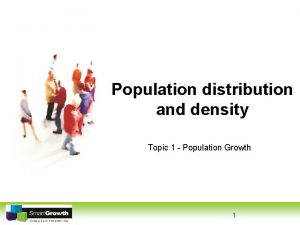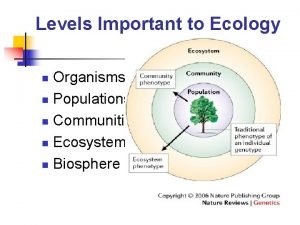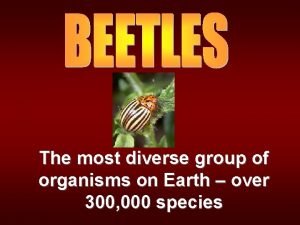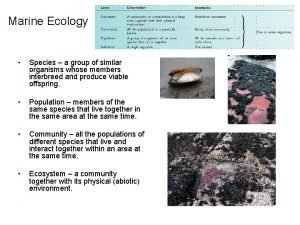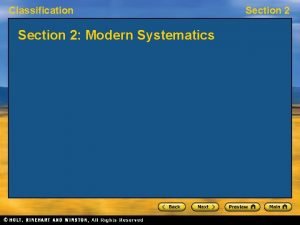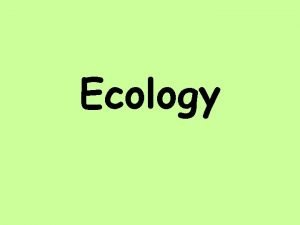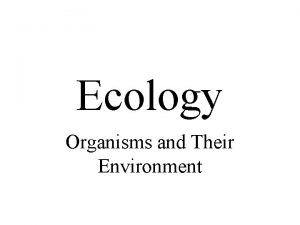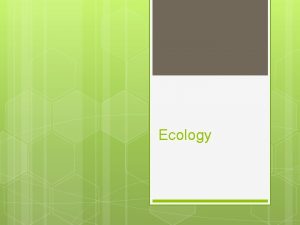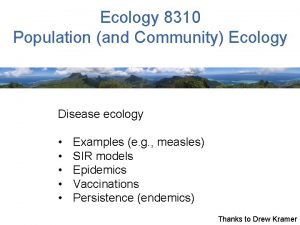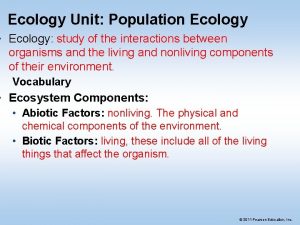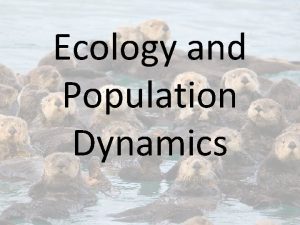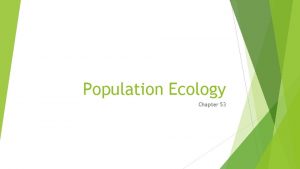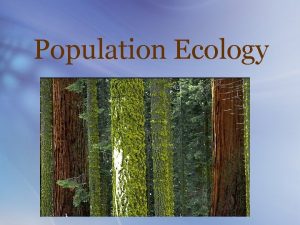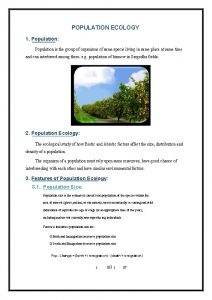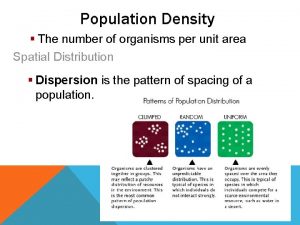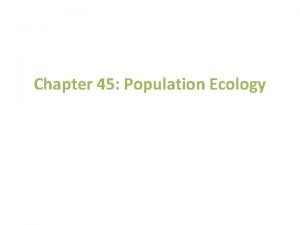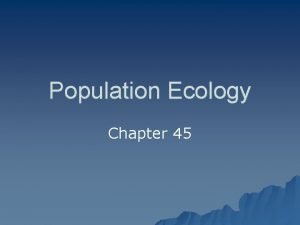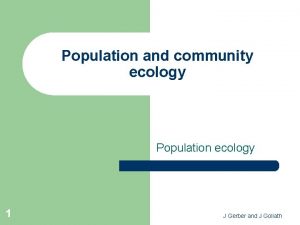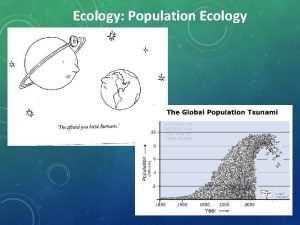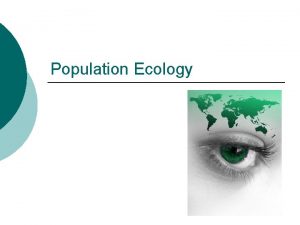Population Ecology Population Group of organisms of a




































- Slides: 36

Population Ecology

Population • Group of organisms of a single species that lives in a given area.

Studying Populations – Geographic range (what is area inhabited by population? ) – Density (how many individuals in an area? ) – Distribution (how are they spaced out in their range? ) – Growth Rate (increasing, decreasing, staying the same? ) – Age Structure (how many mature reproducing individuals versus juveniles? ) – Males to Females (only females can produce young)

Factors Affecting Population Growth • Birthrate: – if more individuals are born than die the population grows • Death Rate – If more individuals die than are born the population shrinks • Emigration: (individuals leaving) populations shrink • Immigration: (individuals entering) population grows

Population Explosion Mice in Australia: http: //www. youtube. com/watch? v=z. WVw-j 8 e. YSk&safe=active • Will happen if: – Population has all the food & resources it needs – Free from predators and disease – Waste is removed • The size of each generation gets bigger and bigger • Eventually a population’s growth will level off and stabilize when the ecosystem reaches it’s carrying capacity


Carrying Capacity – Maximum population that can be supported by the resources in the environment. – Birth and death rates of an organism are balanced

Limiting Factors • Environmental factors affecting organisms ability to survive • Usually present in the shortest supply • Can be biotic or abiotic

Examples of Limiting Factors: – Amount of resources available (food water, nutrients, nesting sites) – Competition for resources (caused when niches overlap) – Predation (Predators keep prey populations in check) – Parasitism (how weakened are individuals by parasites? ) – Disease – Natural Disasters & Unusual Weather

Human Population Growth • For most of human existence, population grew slowly and was kept in check due to many limiting factors that kept human death rates high.

• Advances in civilization (especially after the Industrial Revolution 1800 s) reduced the death rate substantially and increased human lifespan: – Medicine (better healthcare) – Agriculture (better nutrition and more reliable) – Sanitation (less contamination of food and drinking water reduced disease)

• It can’t grow forever, eventually the resources will become too limiting

– Population Ecology Video: http: //www. youtube. com/watch? v=RBOsqm. BQBQk&safe=active – Mouse Population Experiment: http: //www. youtube. com/watch? v=0 Z 760 XNy 4 VM&safe=active – Human Population Growth Video: http: //www. youtube. com/watch? v=E 8 dk. WQVFAo. A&safe=active

Needs of a Growing Human Population • Food • Energy: help keep us warm and run our machines • Living space for both houses and farmland • Resources – Make housing, clothing – Make all the other stuff people have to buy

Effects of Human Population Growth on the Environment • Species are disappearing at a rate of about one species per day • Remember the most stable environments have a high level of BIODIVERSITY – (Many different types of species) • Every species that is lost causes “ripples” through an ecosystem.

Overhunting: • Can lead to extinction and endangerment • Remember: Lowering population of one species affects others • Ex: Blue Whale – – Blue Whale: http: //www. youtube. com/watch? v=9 pj. I 2 Xkmo. L 0&safe=active History of Whaling: http: //www. youtube. com/watch? v=2 n. Fdq. Cr 0 A 1 A&safe=active

• Ex: Bison: • Historically, bison numbered an estimated 20 -30 million. Unregulated shooting of bison, culminated in mass slaughters during the 1870 s, reduced the population to 1, 091 in 1889. • Today, approximately 500, 000 bison live across North America. Most are not pure bison but rather have been cross-bred with cattle in the past and are raised as livestock on ranches. Fewer than 30, 000 bison are in conservation herds, and fewer than 5, 000 are free-ranging and disease-free.

• Ex: Tasmanian Tiger (extinct)

Importation of Nonnative Organisms: – Transfers organisms into communities where they normally don’t exist – Factors that would naturally limit it’s population growth (predators, parasites) may not exist in the new environment so population explodes – This may displace other species through competition for resources and disrupt the existing ecosystem. – Ex: – Starlings, goats, cats, pigs, japanese beetles, gypsy moths, boxer crabs, zebra mussels, mugwort, purple loosestrife, kudzu


Exploitation of Wildlife: • http: //www. youtube. com/watch? NR=1&feature=endscreen&v=Nede. FHCg 1_Y&safe=active • Ex: – Ivory (elephant and walrus tusks) – Bird feathers – Fur from beavers, otters, etc. – Exotic animals for pet stores – Animal parts for “traditional” medicinal uses: • Ex: Rhino horn


Poor Land Management: • Growth of cities and suburbs has destroyed many natural habitats • Deforestation – Allows for soil erosion • Draining of wetlands – Destroys fish nurseries • Soil used for farming can become depleted of nutrients (ex: Dust Bowl)

Water Pollution: – Nitrates (from fertilizer runoff), phosphates, oil, detergents, heavy metals (like mercury), plastic refuse – Pollutants can be concentrated in the food chain • Biomagnification


Air Pollution: – Acid Rain: sulfur and nitrogen oxides produced by factories combine with water in the air and fall as rain. • Plants can wither and die • Organisms living in lakes can die

– Greenhouse Effect: increasing carbon dioxide (from burning fossil fuels) may cause increases in global temperature – Ozone Depletion: by CFC pollution (from aerosol cans) increases our exposure to UV radiation and increases rates of skin cancer

Use of Chemical Pesticides & Herbicides: – Chemicals that destroy insects and weeds may damage other wildlife – Wash into the soil, go into our air and water – BIOMAGNIFICATION in food chain – Ex: DDT

• Waste Disposal: – Biodegradable vs. Nonbiodegradable Waste • Do you know the difference? – Plastic, metal cans, cardboard, paper, electronics, chemicals, biological waste

Positive Improvements • We are now recognizing the harm we are doing to the environment and are taking certain measure to help • Population Control: – encourage people to have fewer children – birth control methods

Encourage Conservation of Resources: – Conserve water, energy – Reforestation – Reduce, Reuse, Recycle Establish Pollution Controls – Use less fossil fuels – Factories have filters on smokestacks – Unleaded gasoline – Recycling campaigns

Species Preservation: – Limits on hunting and fishing – Wildlife refuges, national parks – Preserve habitat of endangered species – Ex: Peregrine falcons, bald eagles

– Provide Nesting Sites • Ex: Blue bird vs. Starling – Special breeding programs • Ex: Black footed ferrets • http: //www. youtube. com/watch? v=Aw. Xk_Skgz 0 A& safe=active

State Environmental Protection Laws: – Hunting and fishing seasons and permits, limits to size of catch – Certain animals cannot be hunted – Protection of breeding sites (ex: piping plover)

Use of Biological Controls to Control Pests: – Use instead of spraying harmful chemicals in environment – Introduce natural predator to help limit population of specie • Wolves: http: //www. youtube. com/watch? v=iy. CZqk. Xf_8&safe=active • Ladybugs and Praying Mantis: – Sterilize individuals to prevent fertile mating of insects – Use pheromones to lure and trap harmful insects • Ex: Tse Fly:

• Well…we thought it was a good idea… • Cane Toad Disaster in Australia – – – Brought in to help eliminate insects that ate sugar cane Skin contains a toxic poison that kill animals that try to eat it. Population has now risen to epic proportions Has endangered many other species (especially snakes) http: //www. youtube. com/watch? v=r. I 8 Ii. Lq. IEV 0&safe=active
 Chapter 4 section 1 population dynamics study guide
Chapter 4 section 1 population dynamics study guide Section 1 population dynamics
Section 1 population dynamics Population ecology section 1 population dynamics
Population ecology section 1 population dynamics Chapter 4 population ecology section 1 population dynamics
Chapter 4 population ecology section 1 population dynamics Organisms ecology
Organisms ecology Principles of ecology section 2.1 worksheet answers
Principles of ecology section 2.1 worksheet answers Principles of ecology organisms and their relationships
Principles of ecology organisms and their relationships Why do organisms interact with other organisms
Why do organisms interact with other organisms Unicellular organisms and multicellular organisms
Unicellular organisms and multicellular organisms Clumped dispersion
Clumped dispersion Define exponential population growth
Define exponential population growth Population vs community ecology
Population vs community ecology Ecosystem vs community
Ecosystem vs community Concept 3 population ecology
Concept 3 population ecology Chapter 53 population ecology
Chapter 53 population ecology Equilibrial life history
Equilibrial life history Chapter 4 population ecology answer key
Chapter 4 population ecology answer key Population def ecology
Population def ecology Chapter 53 population ecology
Chapter 53 population ecology Characteristics of population ecology
Characteristics of population ecology Chapter 4 population ecology answer key
Chapter 4 population ecology answer key Population characteristics ecology
Population characteristics ecology What is population ecology
What is population ecology Population definition ecology
Population definition ecology Population distribution
Population distribution Population ecology
Population ecology Chapter 53 population ecology
Chapter 53 population ecology Most diverse group of organisms
Most diverse group of organisms Environmental resistance factors
Environmental resistance factors Section 2 modern classification
Section 2 modern classification Group polarization simple definition
Group polarization simple definition Y = a(b)^x
Y = a(b)^x Anova within group and between group
Anova within group and between group Social group examples
Social group examples Group 1 vs group 2 specialties
Group 1 vs group 2 specialties Thermal decomposition of group 1 nitrates
Thermal decomposition of group 1 nitrates Amino group and carboxyl group
Amino group and carboxyl group
























